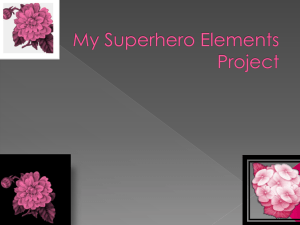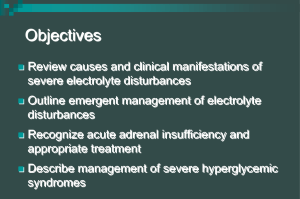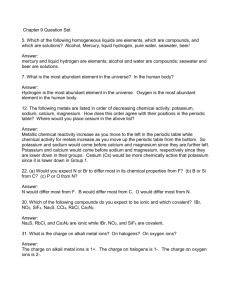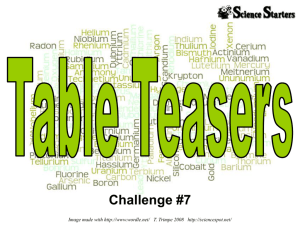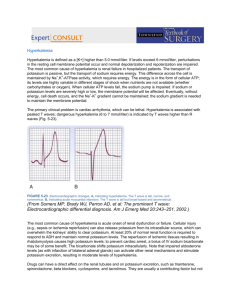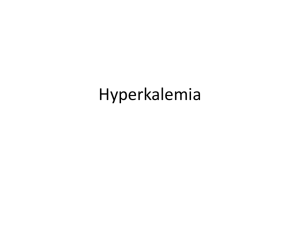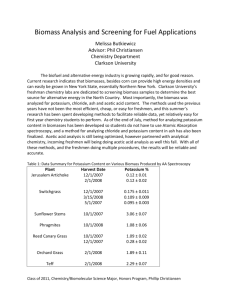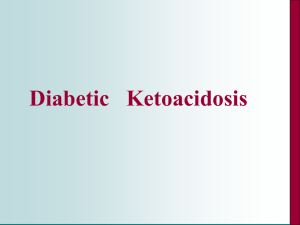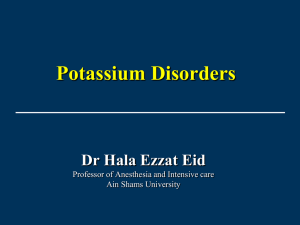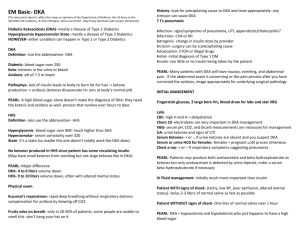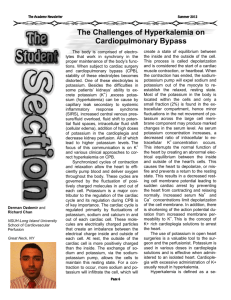Hyperkalemia Show Notes (Word Format)
advertisement
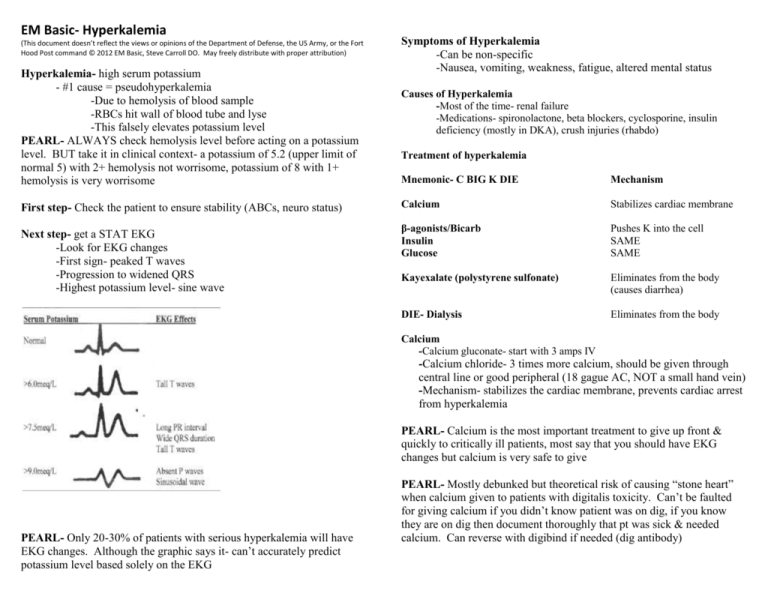
EM Basic- Hyperkalemia (This document doesn’t reflect the views or opinions of the Department of Defense, the US Army, or the Fort Hood Post command © 2012 EM Basic, Steve Carroll DO. May freely distribute with proper attribution) Hyperkalemia- high serum potassium - #1 cause = pseudohyperkalemia -Due to hemolysis of blood sample -RBCs hit wall of blood tube and lyse -This falsely elevates potassium level PEARL- ALWAYS check hemolysis level before acting on a potassium level. BUT take it in clinical context- a potassium of 5.2 (upper limit of normal 5) with 2+ hemolysis not worrisome, potassium of 8 with 1+ hemolysis is very worrisome First step- Check the patient to ensure stability (ABCs, neuro status) Next step- get a STAT EKG -Look for EKG changes -First sign- peaked T waves -Progression to widened QRS -Highest potassium level- sine wave Symptoms of Hyperkalemia -Can be non-specific -Nausea, vomiting, weakness, fatigue, altered mental status Causes of Hyperkalemia -Most of the time- renal failure -Medications- spironolactone, beta blockers, cyclosporine, insulin deficiency (mostly in DKA), crush injuries (rhabdo) Treatment of hyperkalemia Mnemonic- C BIG K DIE Mechanism Calcium Stabilizes cardiac membrane β-agonists/Bicarb Insulin Glucose Pushes K into the cell SAME SAME Kayexalate (polystyrene sulfonate) Eliminates from the body (causes diarrhea) DIE- Dialysis Eliminates from the body Calcium -Calcium gluconate- start with 3 amps IV -Calcium chloride- 3 times more calcium, should be given through central line or good peripheral (18 gague AC, NOT a small hand vein) -Mechanism- stabilizes the cardiac membrane, prevents cardiac arrest from hyperkalemia PEARL- Calcium is the most important treatment to give up front & quickly to critically ill patients, most say that you should have EKG changes but calcium is very safe to give PEARL- Only 20-30% of patients with serious hyperkalemia will have EKG changes. Although the graphic says it- can’t accurately predict potassium level based solely on the EKG PEARL- Mostly debunked but theoretical risk of causing “stone heart” when calcium given to patients with digitalis toxicity. Can’t be faulted for giving calcium if you didn’t know patient was on dig, if you know they are on dig then document thoroughly that pt was sick & needed calcium. Can reverse with digibind if needed (dig antibody) β-agonists- Albuterol neb- one hour neb will bring potassium down approximately 0.5 meq- no IV access required If mild hyperkalemia (6.0 without EKG changes) can start with a beta agonist neb & some insulin/glucose- don’t have to throw kitchen sink at the patient unless they are super sick Mechanism- Drives potassium into the cells Contact- steve@embasic.org Bicarb- only truly works if the patient is acidotic- DO NOT give in patients with DKA unless they are really sick- fixing their DKA will drive down their potassium Mechanism- Drives potassium into the cells (if acidotic) Insulin/Glucose- 10 units of regular insulin IV with one amp of glucose (D50)- check blood sugar first before giving glucose. May not need insulin in patient without diabetes or a patient with high blood sugar but little harm in giving both insulin/glucose Mechanism- Drives potassium into the cells (insulin required to bring glucose into the cell) Kayexalate (polystyrene sulfonate)- binding resin that supposedly binds potassium but more likely mechanism is causing diarrhea- not a lot of evidence that it works and can cause harm & can take hours to work. Dose- 15 grams PO or 30 grams PR Mechanism- Eliminates potassium from the body (via diarrhea) Lasix (furosemide)- lasix kind of sounds like lasik if you use your imagination- loop diuretic that causes potassium to be excreted into the urine, takes hours to work. Can worsen kidney function- use caution unless already actively on dialysis Dose- 30 mg IV or daily PO dose as an IV dose Mechanism- eliminates potassium via urine Dialysis- the last step in any patient with severe hyperkalemia, especially useful if patient is already on dialysis- do all the other treatments first you are waiting on nephrology to dialyze Twitter- @embasic
